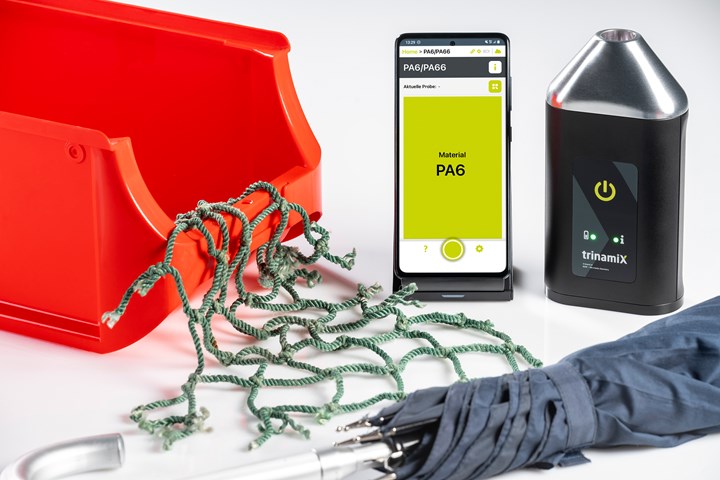Distinguishing Nylon 6 from Nylon 66 at the Push of a Button
BASF’s subsidiary trinamiX adds new application for plastic sorting to its mobile NIR spectroscopy solution.
|
The ability to distinguish nylon 6 from nylon 66 at the push of a button in the latest application for plastic sorting added to the Mobile NIR Spectroscopy Solution from Germany-based trinamiX GmbH. Founded in 2015 as a wholly-owned subsidiary of BASF, Germany-based trinamiX GmbH (trinamixsensing.com) develops and sells cutting-edge 3D vision and infrared sensing solutions for use in both consumer electronics devices and industrial designs. Launched last year, trinamiX’s solution combines robust hardware with intelligent data analysis and a mobile app. NIR spectroscopy is a proven technology that trinamiX has integrated into a portable format for on-site analysis. In doing so, trinamiX relies on cloud-based data processing, which ensures continuous development of the solution – there is no need to replace hardware. This way, trinamiX can continuously develop new applications and react flexibly to new challenges in the field of plastic sorting – while working closely together with customers as in the case of its new nylon 6/nylon 66 application.  |
|
According to the company, plastic waste from the two nylons can be sorted within seconds using a handy measuring device as part of trinamiX’s solution. With this new application, trinamiX is responding to customer wishes and expands its broad offering for plastic sorting. Nylons 6 and 66 are among the most sought after engineering plastics. Thanks to their robustness, they are suitable for a wide range of applications – from fishing nets to resilient components. Since nylons 6 and 66 have similar properties, they are used interchangeably in numerous applications--and it is virtually impossible to distinguish them with the naked eye. At the same time, the separation of nylons 6 and 66 has gained traction in recent years in light of growing requirements within the recycling industry. As a result, the production of high-quality singlegrade plastic recyclates--including nylon 6 and nylon 66--is becoming increasingly lucrative. Explained Adrian Vogel, sales and business development manager for trinamiX’ spectroscopy solutions, "For many recycling companies, sorting nylon 6 and nylon 66 previously involved a cumbersome analysis process – and, therefore, proved often times neither profitable nor feasible. With our new application, recycling companies can quickly determine the nylon type and process the waste streams accordingly." Besides the recycling industry, plastics processing companies who rely on nylons 6 and 66 in their products also benefit from trinamiX's new application. They are now enabled to perform a clean separation of nylons 6 and 66 production rejects or waste. In-house recycling processes can thus be geared towards an optimized and more efficient use of valuable resources. In addition to distinguishing nylons 6 and 66, trinamiX Mobile NIR Spectroscopy Solution can already identify all common plastics - from classic polyolefins such as PE and PP, to PET and engineering plastics such as ABS. Recycling companies as well as manufacturers, traders and processors of goods made from recyclate benefit from a flexible and mobile solution that offers user-oriented applications for the sorting of plastic components and packaging materials. |
Related Content
-
At NPE2024, Follow These Megatrends in Materials and Additives
Offerings range from recycled, biobased, biodegradable and monomaterial structures that enhance recyclability to additives that are more efficient, sustainable and safer to use.
-
NPE2024 Materials: Spotlight on Sustainability with Performance
Across the show, sustainability ruled in new materials technology, from polyolefins and engineering resins to biobased materials.
-
Latest Data on Bottled Water Shows Continued Strong Growth
Bottled water’s volume surpassed soft drinks for the first time in 2016 and has done so every year since.












